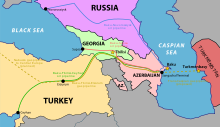Baku-Tbilisi-Ceyhan pipeline
| Baku–Tbilisi–Ceyhan pipeline | |
|---|---|

Location of Baku–Tbilisi–Ceyhan pipeline
|
|
| Location | |
| Country | Azerbaijan, Georgia, Turkey |
| General direction | east–south-west |
| From | Baku (Sangachal Terminal), Azerbaijan |
| Passes through | Tbilisi Georgia, Erzurum Turkey, Sarız Turkey |
| To | Ceyhan, Turkey |
| Runs alongside | South Caucasus Pipeline |
| General information | |
| Type | oil |
| Partners | BP, SOCAR, Chevron, Statoil, TPAO, Eni, Total S.A., , Inpex, ConocoPhillips, Hess Corporation |
| Operator | BP |
| Commissioned | 2006 |
| Technical information | |
| Length | 1,768 km (1,099 mi) |
| Maximum discharge | 1 million barrels (160,000 m3) of oil per day |
The Baku–Tbilisi–Ceyhan (BTC) pipeline is a 1,768 kilometres (1,099 mi) long crude oil pipeline from the Azeri-Chirag-Guneshli oil field in the Caspian Sea to the Mediterranean Sea. It connects Baku, the capital of Azerbaijan and Ceyhan, a port on the south-eastern Mediterranean coast of Turkey, via Tbilisi, the capital of Georgia. It is the second-longest oil pipeline in the former Soviet Union, after the Druzhba pipeline. The first oil that was pumped from the Baku end of the pipeline reached Ceyhan on 28 May 2006.
The Caspian Sea lies above one of the world's largest collections of oil and gas fields. As the sea is landlocked, transporting oil to Western markets is complicated. During Soviet times, all transportation routes from the Caspian region were through Russia. The collapse of the Soviet Union inspired a search for new routes. Russia first insisted that the new pipeline should pass through its territory, then declined to participate.
In the spring of 1992, the Turkish Prime Minister Süleyman Demirel proposed to Central Asian countries including Azerbaijan that the pipeline run through Turkey. The first document on the construction of the Baku–Tbilisi–Ceyhan pipeline was signed between Azerbaijan and Turkey on 9 March 1993 in Ankara. The Turkish route meant a pipeline from Azerbaijan would run through Georgia or Armenia, but the route through Armenia was politically impossible due to the unresolved war between Armenia and Azerbaijan over the status of Nagorno-Karabakh. This left the circuitous Azerbaijan-Georgia-Turkey route, longer and more expensive to build than the other option.
The project gained momentum following the Ankara Declaration, adopted on 29 October 1998 by President of Azerbaijan Heydar Aliyev, President of Georgia Eduard Shevardnadze, President of Kazakhstan Nursultan Nazarbayev, President of Turkey Süleyman Demirel, and President of Uzbekistan Islam Karimov. The declaration was witnessed by the United States Secretary of Energy Bill Richardson, who expressed strong support for the pipeline. The intergovernmental agreement in support of the pipeline was signed by Azerbaijan, Georgia, and Turkey on 18 November 1999, during a meeting of the Organization for Security and Cooperation in Europe (OSCE) in Istanbul, Turkey.
...
Wikipedia
